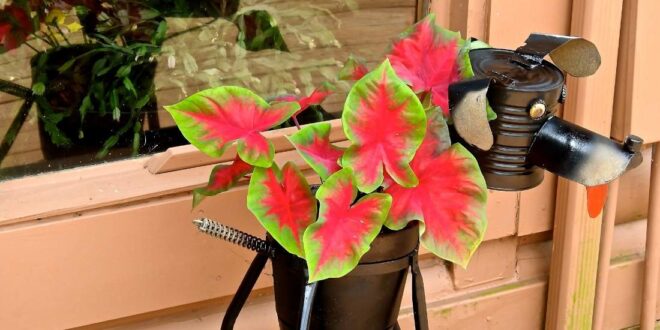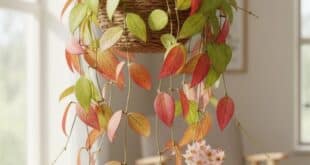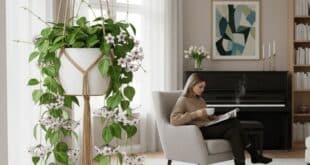Caladium: Your Home’s Living Art Masterpiece!
The Caladiums are genus of spectacular foliage plants, celebrated not for its flowers, but for its vibrant, heart-shaped leaves that bring breathtaking color to shady corners of a home or garden.
Imagine a plant with leaves so vividly painted, so uniquely patterned, they look like miniature works of art – each one a tiny masterpiece! That’s the magic of the Caladium! Often called Angel Wings, these stunners are truly in a league of their own.
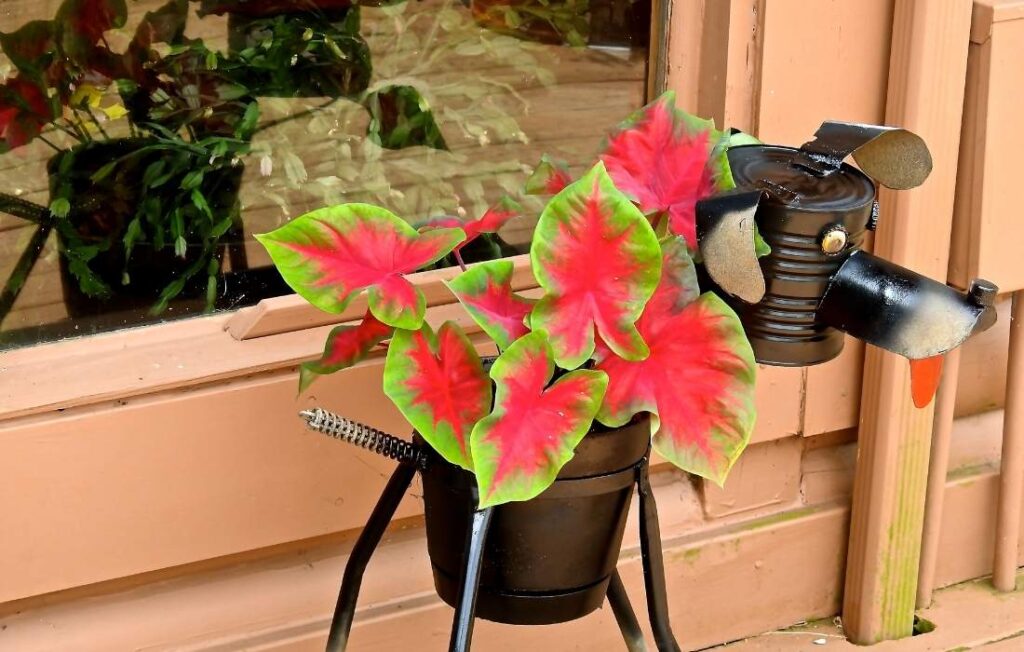
Hailing from the warm, shady rainforests of South America, Caladiums bring an unparalleled burst of color – think vibrant pinks, fiery reds, pure whites, and lush greens – right into your home. They’re unique because they grow from little underground tubers and have a special seasonal rhythm. Ready to add this incredible, living artwork to your collection? Let’s uncover everything you need to know to make your Caladium shine!
What Makes a Caladium So Unique? Its Painted Leaves and Delicate Beauty
You’ll find yourself utterly mesmerized by the striking leaves of a Caladium. They’re often heart-shaped or arrow-shaped and feel surprisingly paper-thin and delicate, almost like a piece of silk. But what truly sets them apart is their incredible color palette! Each leaf is like a canvas, painted with intricate patterns of contrasting veins, bold splashes, or beautiful blotches in shades of red, pink, white, and various greens. It’s a plant that screams “look at me!”
Unlike many houseplants, Caladiums grow from a tuber (like a little underground potato). This means they have a natural seasonal growth cycle – they put on a spectacular show of leaves for several months, then take a peaceful nap.
Where Do Caladiums Come From? South America’s Shady Rainforests
Your Caladium’s ancestors come directly from the steamy, warm rainforests of South America, particularly around the Amazon basin in Brazil. In their natural homes, they thrive on the forest floor, enjoying the dappled light and constant humidity found beneath the dense canopy of taller trees. This origin tells us exactly why they love warmth, humidity, and filtered light in our homes! It also explains their unique dormancy cycle – in their natural environment, they might “rest” during drier periods.
What Are Its Other Names? “Angel Wings” and Its Allure
The most popular nickname for Caladiums is “Angel Wings,” which perfectly captures the delicate, almost ethereal beauty of their heart-shaped leaves. They truly look like they could belong to something heavenly! The allure of Caladiums comes from this delicate beauty combined with their incredibly bold and artistic colors, making them truly captivating.
What Kinds of Caladiums Are There?
Caladiums offer a breathtaking spectrum of colors, much like a sprawling art gallery! While they all share that signature painted leaf, you’ll find them in amazing varieties of shapes and patterns.
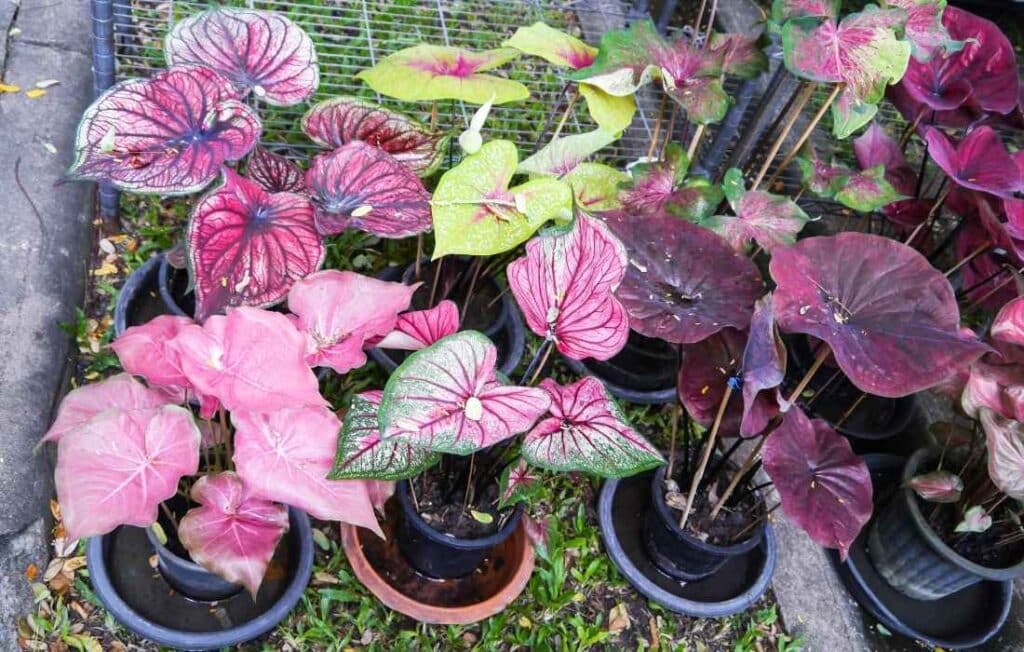
Popular Caladium Types: A Palette of Perfection
Caladiums are generally grouped into two main types based on their leaf shape. Check out some popular examples:
| Type | Leaf Shape/Size | Key Features/Colors | Light Preference |
| Fancy-Leaf | Larger, classic heart-shaped | Often bold veins, broad colorful splashes (Red Flash, White Christmas) | Prefers more shade/filtered light |
| Strap-Leaf | The leaves are narrower and distinctly arrow-shaped. | You’ll frequently see ruffled or thinner foliage with striking, vibrant colors in cultivars like ‘Florida Red Ruffles’ and ‘Candyland’. | They handle a slightly higher amount of sun. |
Leaf Looks: Colors, Patterns, and Shapes
Caladiums’ leaves are undoubtedly their canvas, where they genuinely display their artistic flair. Shapes range from broad hearts to elegant arrows or narrower straps. But the colors and patterns are the real show. Envision a stunning palette of fiery reds, delicate pinks, pure whites, creamy yellows, and diverse greens, all intricately patterned with veins, splashes, or blotches across each leaf. Each variety is like a different painting!
Growth Habit: Bushy and Compact
Caladiums typically grow as a compact, bushy plant directly from their underground tubers. They fill out beautifully, creating a dense mound of colorful foliage that makes them perfect for tabletops, windowsills, or as vibrant accents in larger pots.
How Do You Take Care of Your Caladium?
Caladiums might look delicate, but they’re surprisingly easy to care for once you understand their love for warmth, humidity, and their unique seasonal cycle. Consistency is your friend!
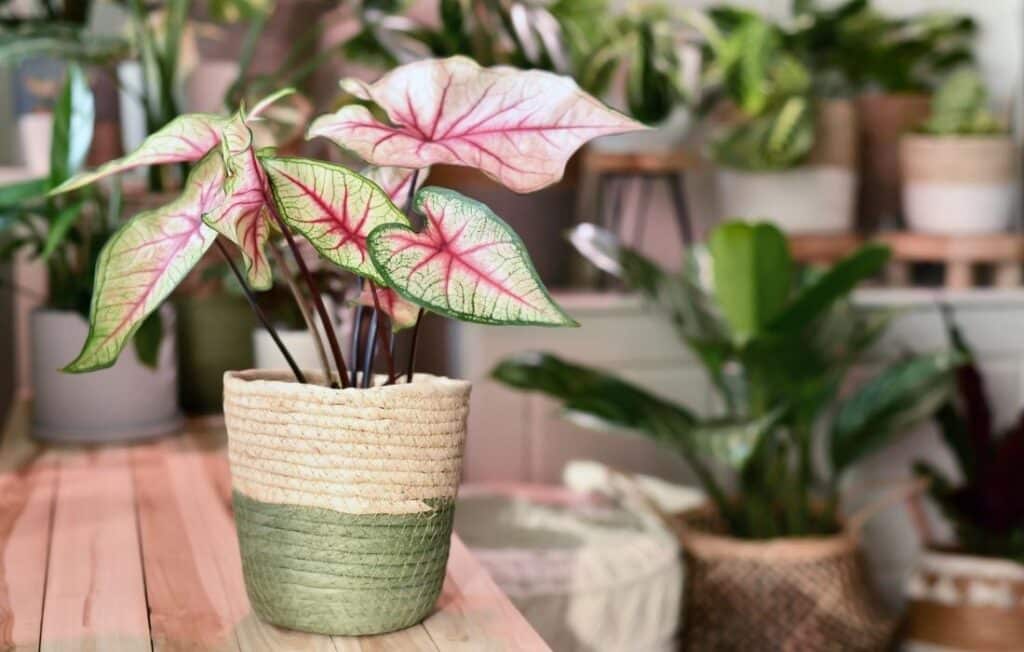
Caladium Care Summary
Here’s a quick overview of what your Caladium loves:
| Care Category | What Your Caladium Needs |
| Light | Bright, indirect light It’s best to keep the plant out of direct sun exposure, especially during the afternoon. |
| Watering | During its active growing period, keep the soil consistently moist, allowing only the top inch to dry out slightly before watering again. Reduce watering as the plant enters dormancy. |
| Temperature | Warm, 65-85°F (18-29°C). Avoid cold drafts. |
| Humidity | These plants thrive in high humidity, which can be provided using a humidifier, pebble tray, or regular misting. |
| Soil | Well-draining, rich potting mix (e.g., standard mix + perlite/coco coir). |
| Pot | Drainage holes are a must! |
| Fertilizing | During its active growth phase (spring and summer), fertilize every 2-3 weeks using a diluted liquid fertilizer. |
The Right Light: Bright, Indirect Light is Best
Your Caladium thrives in bright, indirect light. Imagine the filtered sunlight dancing through a rainforest canopy – that’s precisely the kind of environment where these plants flourish. Intense, direct sunlight will definitely scorch their delicate leaves, causing them to turn brown or crispy.
- A little tip: Fancy-leaf types tend to prefer a bit more shade, while strap-leaf varieties can handle a little more brightness, but always indirect!
Watering Smart: Keep Soil Consistently Moist!
This watering approach is especially vital during their active growing season! Caladiums thrive with consistent moisture but detest waterlogged soil. Water thoroughly when the top inch or two (2.5-5 cm) of soil feels just slightly dry. Never allow the soil to completely dry out when they have leaves, as this will cause them to droop significantly. Always ensure your pot has excellent drainage holes! Once the leaves start to yellow and die back for dormancy (usually in fall/winter), reduce watering significantly.
Cozy Temperatures and High Humidity, Please!
Mimicking their natural rainforest environment, Caladiums thrive in warm temperatures, ideally ranging from 65-85°F (18-29°C). They are quite sensitive to cold drafts and abrupt temperature shifts, so it’s best to place them in a consistently warm and sheltered location. And humidity? Oh, they absolutely adore high humidity! If your home’s air is dry, particularly during winter heating, you’ll likely observe those frustrating brown, crispy tips on their leaves. To provide an ideal environment, consider employing a humidifier, setting the pot on a pebble tray filled with water, or regularly misting them lightly. For misting, using distilled or filtered water is recommended to prevent mineral spots.
Excellent drainage is paramount for your plant’s health.
Caladiums thrive in a well-draining, airy potting mix that also holds onto some moisture. A high-quality indoor potting mix, enriched with additions like perlite, peat moss, or coco coir, makes an excellent growing medium. The key is excellent drainage. Always pick a pot with drainage holes. When planting tubers, use a pot that’s just a bit larger than the tuber itself. You’ll typically repot them (or replant the tubers) each spring.
Feeding Your Caladium: Regular Meals for Vibrant Foliage
To support its vibrant colors and new foliage, your Caladium will benefit greatly from regular fertilization during its active growth period (spring and summer). Use a balanced liquid houseplant fertilizer, or one slightly higher in phosphorus, diluted to half strength, every 2-3 weeks. Once the leaves start to die back for dormancy, stop feeding entirely.
Common Caladium Problems and Their Solutions
Caladiums are pretty expressive, and understanding their unique seasonal cycle is key to avoiding panic!
Common Caladium Problems & Solutions
| Problem | What It Looks Like | Common Cause(s) | How to Fix |
| Leaves Dying Back | Leaves yellow, wilt, disappear | Normal dormancy (late fall/winter) | Don’t panic! This is natural. Reduce water, store tuber until spring. |
| Brown/Crispy Tips/Edges | Dry, brown leaf edges on your Caladium often indicate low humidity or underwatering. | Low humidity, inconsistent watering, or issues with tap water are the usual culprits when your Caladium’s leaf edges start looking dry and brown. | To address this, increase humidity around your plant (using a humidifier or pebble tray). Also, try using filtered water and make sure to water consistently. |
| Fading Colors/Scorched Leaves | Dull colors, brown patches on leaves | Too much direct sunlight | Move to bright, indirect light; protect from harsh sun. |
| Yellowing/Mushy Leaves | Leaves turn yellow, feel soft | Overwatering, soggy soil | Let soil dry out more, check drainage. |
| Drooping Leaves | Leaves look limp/sad | Underwatering (thirsty) OR overwatering (root rot) | Check soil moisture: if dry, water; if soggy, let dry/check roots. |
| Pests | Tiny webs, sticky residue, small bugs | Dry conditions (spider mites), general plant stress | Regularly inspect your plant, and if pests are found, treat them with insecticidal soap or neem oil. |
Is the Caladium Plant Toxic? Safety for Pets
Yes, it’s very important to know: Caladium plants are considered toxic if ingested. They contain little crystals called calcium oxalates, similar to plants like Peace Lilies, ZZ Plants, and Monsteras.
If your cats, dogs, or other pets chew on a Caladium, these crystals can cause significant irritation. You might see symptoms like:
- Intense oral pain and irritation: They might paw at their mouth, drool excessively, or show signs of discomfort.
- Vomiting: is a frequent response following ingestion.
- Difficulty swallowing: Due to irritation in the mouth and throat.
Though typically not life-threatening, it can cause significant discomfort for your pets. So, it’s highly recommended to keep Caladium plants out of reach of curious pets and small children. If you suspect your pet has ingested any part of a Caladium and is showing symptoms, contact your veterinarian immediately for guidance.
Caladium vs. Elephant Ear: Spotting the Differences!
It’s totally understandable to get Caladiums mixed up with other “Elephant Ear” plants like Alocasia or Colocasia! They all have big, bold, heart-shaped or arrow-shaped leaves and bring that amazing tropical vibe. However, there are some key differences that make them unique.
Here’s a quick guide to help you tell them apart:
Caladium vs. Elephant Ear: A Quick Comparison
| Characteristic | Caladium (Angel Wings) | Elephant Ear (Alocasia, Colocasia, Xanthosoma) |
| Scientific Names | Caladium spp. | Alocasia spp., Colocasia spp., Xanthosoma spp. |
| Primary Feature | They feature vibrant, intricate leaf colors and patterns, including shades of red, pink, white, and green. | These plants are characterized by their large size and dramatic leaves, which often come in solid, dark colors. |
| Leaf Texture | Paper-thin, delicate, often matte or slightly velvety | Thicker, often glossy/waxy, can be velvety (some Alocasia) |
| Leaf Shape | Often heart-shaped, arrow-shaped, or strap-like; often more symmetrical | Heart-shaped, arrow-shaped, or shield-like; often more pointed |
| Leaf Color Focus | Expect bold, painterly patterns featuring a spectrum of colors. | Their foliage frequently appears in solid green, deep purple/black, or features large, distinct splotches. |
| Growth From | The tuber is the plant’s underground storage part. | This plant grows from a corm or rhizome, which are different kinds of underground stems. |
| Light Preference | Bright, indirect light (can burn easily in direct sun) | Bright, indirect to full sun (especially Colocasia) |
| Dormancy Cycle | Strongly seasonal! Leaves die back completely in fall/winter. | Some varieties go dormant, but many can be grown evergreen indoors. |
| Growth Habit | Bushy, compact plant with many leaves from tuber | Can be very large! Upright (Alocasia) or droopy/spreading (Colocasia) |
Caladiums for Home Decor: Living Art, Seasonal Splendor
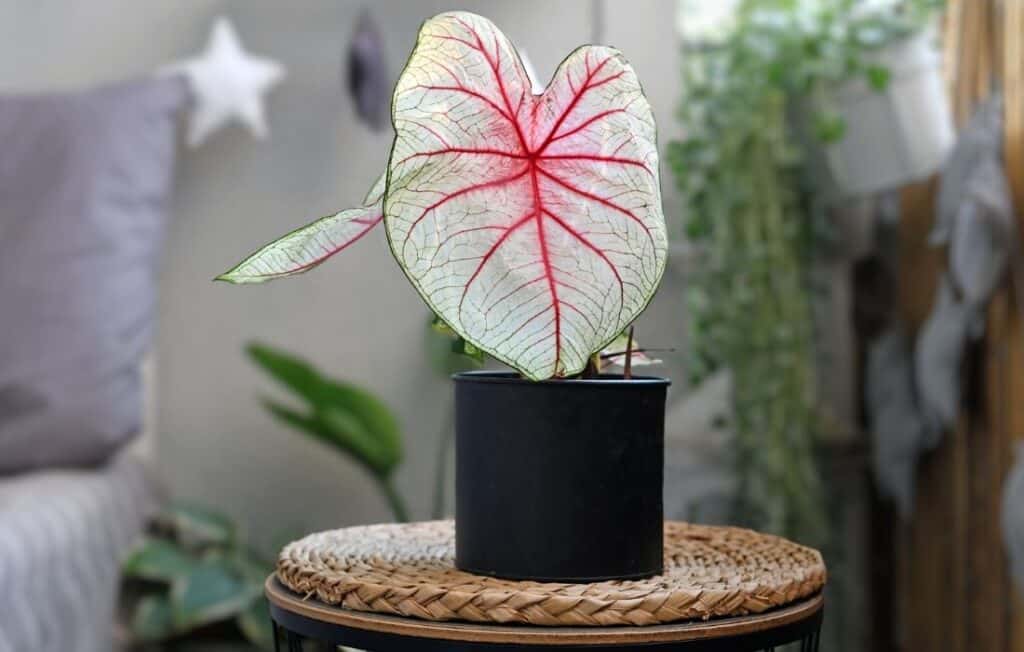
Caladiums are truly living masterpieces that bring incredible visual impact to your home and garden:
Creating a Vibrant Focal Point
With their bold, painted leaves, a Caladium can instantly become a stunning focal point in any room or shaded outdoor area. Its vibrant hues immediately capture attention, lending an artistic touch to any space.
Perfect for Bright, Shady Spots Indoors
Their love for bright, indirect light makes them ideal for brightening up those less sunny corners, tabletops, or windowsills where their colors can truly pop without getting scorched.
Adding Tropical Flair to Outdoor Containers
In warmer months, Caladiums are absolutely fantastic for adding a burst of tropical color to shaded patios, porches, or garden beds. They thrive in containers, allowing you to easily move them indoors for winter.
Seasonal Beauty: A Changing Display
Embrace their natural cycle! The seasonal beauty of Caladiums means you get a spectacular show for several months, followed by a peaceful resting period. It’s like having a revolving art display that reminds you of nature’s rhythm.
Caladiums’ Charm: Nature’s Artistic Masterpiece
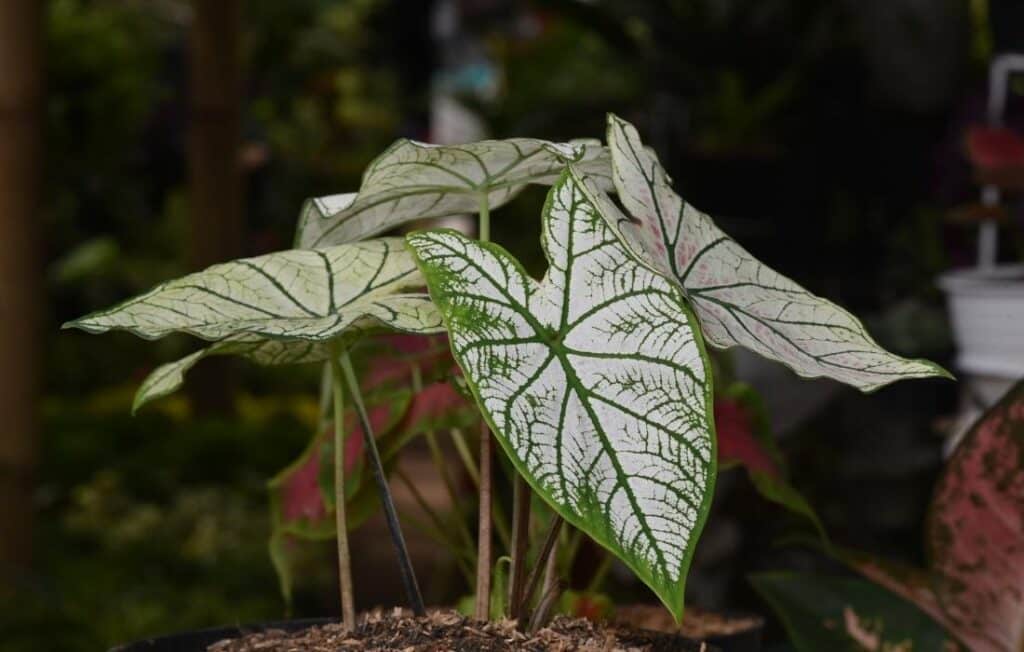
The Caladium plant offers a truly unique and captivating experience for plant lovers. It’s not just a plant; it’s a masterpiece of nature’s art, with each leaf boasting intricate patterns and dazzling colors. While they have specific needs for warmth, humidity, and consistent moisture during their active phase, their seasonal charm and breathtaking beauty make them incredibly rewarding. By understanding their natural rhythm, you can enjoy the vibrant splendor of your Caladium, bringing a touch of tropical artistry into your home year after year.
Frequently Asked Questions (FAQ) About Caladiums
Still have some questions about your beautiful Caladium? Here are some common ones that might help you out!
Q1: Why are all my Caladium leaves dying and turning yellow/brown?
A1: Don’t panic! If this happens in late fall or winter, it’s completely normal. Your Caladium is simply going dormant for its natural resting period. The leaves will die back, and the plant will regrow from its tuber next spring. This is their natural life cycle!
Q2: How often should I water my Caladium?
A2: During its active growing season (when it has leaves), keep the soil consistently moist, but never soggy. Water when the top inch of soil feels slightly dry. Once the leaves start to die back for dormancy, reduce watering significantly or stop altogether.
Q3: Can Caladiums grow in full sun?
A3: Generally, no. Most Caladiums prefer bright, indirect light or partial shade. Full, direct sun, especially harsh afternoon sun, will scorch their delicate leaves, causing them to burn and lose their vibrant color. Some strap-leaf varieties can tolerate a bit more sun, but indirect light is always safest.
Q4: When do Caladiums bloom?
A4: Caladiums do produce a flower (similar to a Peace Lily’s, a spadix and spathe), but they are usually not very showy and are often hidden by the large leaves. Caladiums are primarily cultivated for their breathtaking foliage, rather than for their blooms.
Q5: How do I store Caladium tubers for winter?
A5: Once the leaves have died back completely, you can either leave the tuber in its pot (reducing watering significantly) or carefully dig up the tuber. Clean off any soil, allow it to dry completely for a few days, then store it in a cool, dark, dry place (like a paper bag or mesh bag with some peat moss) until it’s time to replant in spring.
Q6: Can I keep my Caladium alive all year round without dormancy?
A6: It’s very difficult and generally not recommended. While you might keep some leaves by providing ideal conditions (high humidity, consistent warmth, bright light), forcing them to stay active year-round can weaken the tuber, leading to less vigorous growth and fewer leaves in subsequent seasons. It’s best to let them rest naturally.
Q7: Are Caladiums good for air purification?
A7: While many plants help purify the air, Caladiums are not specifically noted on common lists (like NASA’s Clean Air Study) for their air-purifying capabilities. People grow them for their stunning visual appeal.
Q8: Why are my Caladium’s colors dull or fading?
A8: If your Caladium’s vibrant colors are dulling or fading, it’s usually a sign that it’s not getting enough bright, indirect light. The pigments that give them their amazing hues need good light to develop.
- The Fix: Move it to a brighter spot, but still avoid direct sun!
Q9: Is the Caladium plant safe for my pets?
A9: Caladium plants are indeed considered toxic if ingested by cats, dogs, and other pets. This is because they contain calcium oxalate crystals, which can lead to irritation in the mouth, throat, and stomach. It’s best to keep them out of reach of curious animals.

